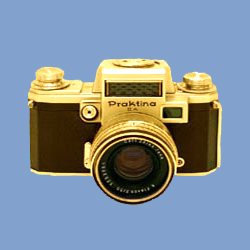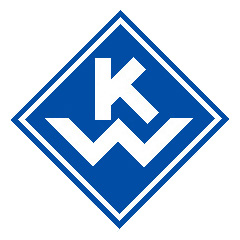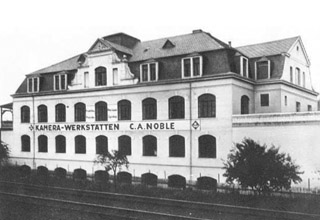| | SITE MAP | | | PREVIOUS PAGE | |
 |
THE PRAKTINA SYSTEM CAMERAS |
The company that made the Praktina cameras
The company that manufactured the Praktina cameras is renowned for the 35mm single-lens reflex cameras produced since 1939. The history began in 1919 and ended in 1990. During this long period, the company changed name, location and logo many times.
Company Name Changes
1919 Kamera-Werkstätten Guthe & Thorsch GmbH
1938 Kamera-Werkstätten, vormals Guthe & Thorsch
1939 Kamera-Werkstätten Charles A. Noble
1946 Kamera-Werkstätten Niedersedlitz, Betrieb der Industrieverwaltung 24 Optik, Volseigener Betrieb Sachsen Dresden-Niedersedlitz
1947 MECHANIK Kamera-Werkstätten VEB Niedersedlitz
1951 OPTIK Kamera-Werkstätten VEB Niedersedlitz
1953 VEB Kamera-Werke Niedersedlitz Dresden A 17
1959 VEB Kamera- und Kinowerke Dresden
1964 VEB PENTACON DRESDEN Kamera- und Kinowerke
1968 Kombinat VEB PENTACON DRESDEN
1985 VEB PENTACON DRESDEN
1990 PENTACON DRESDEN GmbH
Changes in the Locations
1919 Dresden, Serre-Straße 12 and (office) Zinzendorfstraße 48
1928 Dresden, Bärensteiner Straße 30
1939 Niedersedlitz, Bismarkstraße 56
1946 Niedersedlitz, Edgar-André-Straße 56, previously called Bismarkstraße
1959 Dresden, Schandaurer Straße 76
Logo Evolution
 1919 - 1958 |
 1959 - 1963 |
 1964 - 1990 |
The KW History
1919 - 1938
Paul Guthe owned a small factory of photographic equipment in Dresden, Ferdinandplatz 1, since 1915. In 1919 Paul Guthe and Benno B. Thorsch established in Dresden a partnership with the name Kamera-Werkstätten Guthe & Thorsch GmbH. In 1928, the company moved to new premises, in Bärensteiner Strasse 30, near the Ica-Werk of Zeiss Ikon AG. Two years later the production exceeded the 100 cameras per day with 150 workers.
During the 1920s and 1930s, the Kamera-Werkstätten manufactured plate cameras and medium format reflex. The plate camera Patent-Etui 9x12, a flat folding camera that met a great success, was introduced in 1920, the Patent-Etui 6.5x9 in 1923, the twin lens reflex camera Pilot Reflex 3x4 in 1931, the 6x9 single-lens reflex Reflex-Box in 1933, the 6x6 single-lens reflex camera Pilot 6 in 1935 and the Pilot Super in 1939.
At the beginning of 1930, Paul Guthe resigned from the company for health reasons. He died in December of 1930. The old partnership was dissolved in April 1930 but the name of the company was not changed and Benno Thorsch went on leading the company as sole owner.
In 1937, Benno Thorsch needed to leave Nazi Germany because, as being half Jew, he feared for his life. The opportunity came when he met Charles A. Noble who wanted to move to Germany to open a business in the photography sector. Charles A. Noble was of German origin. He emigrated to the USA in 1922 where he became US citizen. He was the owner of a company in Detroit that manufactured photocopiers.
At the beginning of 1938, Benno Thorsch found an agreement with Charles A. Noble that provided for the exchange of ownership of their respective companies. Before to emigrating to the USA, Benno Thorsch sold the Kamera-Werkstätten to Charles A. Noble and bought the Noble's company in the USA.
Charles A. Noble became the new owner in April 1938 and the company was renamed Kamera-Werkstätten, vormals Guthe & Thorsch.
1939 - 1946
Charles A. Noble moved the company to Niedersedlitz, near Dresden, into the building of a former factory of drops and sweets. The company changed the name to Kamera-Werkstätten Charles A. Noble. In the spring of 1939, at the Leipzig trade fair, was introduced the Praktiflex. The design of this camera began in 1937 and was developed by Benno Thorsch and Alois Hoheisel. The new camera was a 35mm single-lens reflex with fixed waist-level finder and interchangeable lens with a 40mm thread mount. The Praktiflex was presented three years after the Kine-Exakta introduced in 1936 by Ihagee Kamerawerk Steenbergen & Co.

After the US entry into World War II, Mr. Noble and his family, as Americans, were restricted in their ability to leave Germany but retained their company.
Between 13 and 15 February 1945 the centre of Dresden was completely destroyed by the British and American bombing. It was estimated that about the 80% of the photographic industries were heavily damaged. The factory of Kamera-Werkstätten remained intact because it was situated in Niedersedlitz, in the outskirts of Dresden. Soviet troops occupied Dresden in May 1945. In 1945 the Soviets arrested C.A. Noble and his son John for spying. For father and son began an odyssey through the Soviet concentration camps. The father was released in 1952 and John in 1955 and could return to the US.
After the end of WWII, Germany was partitioned into four military occupation zones. The sectors controlled by France, United Kingdom and United States were merged in May 1949 to form the Federal Republic of Germany known as West Germany. In October 1949 the sector controlled by the Soviet Union became the German Democratic Republic, known as East Germany.
1947 - 1952
In 1947 the Kamera-Werkstätten was nationalized by the German Government with the name "Kamera-Werkstätten VEB Niedersedlitz - Betrieb der Industreverwaltung 24 OPTIK, Volkseigener Betrieb Sachsens" and the production of Praktiflex was claimed as war reparations by the Soviet Union.
The production capacity of the Kamera-Werkstätten was on the increase as well as the number of employees: 288 in 1946, 330 in 1948, 520 in 1950 and more than 1,000 in 1953.
In 1949 was introduced the Praktica, a 35mm SLR with 42x1 thread mount and no flash sync.
In 1952 the Kamera-Werkstätten showed the prototype of the Praktina, first 35mm single-lens reflex camera with the interchangeability of lenses, finders, focusing screens, camera back and with the ability to use an electric or a spring motor drive.
1953 - 1958
In 1953 the company changes its name to "VEB Kamera-Werke Niedersedlitz" and the production of the Praktina FX begins. In 1956 the Kamera-Werke introduced the Praktica FX2 with an internal mechanism for closing the diaphragm of the lens and the Praktisix 6x6, a single-lens reflex with full automatic control of the lens diaphragm and with interchangeability of screens and finders. In 1958 the Kamera-Werke introduced the Praktina IIA with the full automatic control of the lens diaphragm.
1959 - 1963
On the first of January VEB Kamera-Werke Niedersedlitz, VEB Kinowerke Dresden, VEB Altissa-Camera-Werke, VEB Aspecta Dresden and VEB Welta-Kamera-Werke merged together in a new company under the name VEB Kamera- und Kinowerke Dresden. The KW logo was replaced by the Zeiss Tower logo.
In 1959 was introduced the Praktica IV fitted with a fixed eye-level finder and in 1961 the Pentina a 35mm single-lens reflex with leaf-shutter, fixed eye-level finder, exposure meter and interchangeable bayonet mount.
After the merge, the new company had in production three different 35mm single-lens reflex cameras: Contax/Pentacon, Praktica and Praktina. These cameras required two different sets of lenses, with thread and bayonet mount, and different accessories. In 1960, to reorganize the production, the Company decided to stop the production of Praktina and Contax/Pentacon and to develop future cameras based on the Praktica design that was easier and cheaper to manufacture than the Contax and Praktina.
1964 - 1967
On the first of January the company changed name to "VEB PENTACON DRESDEN Kamera- und Kinowerke" and the logo was updated by adding the name Pentacon to the Zeiss Tower symbol.
The Praktica V, with instant-return mirror, and the Praktica "nova" series were introduced in 1964. Among the models of this line we must mentioned the Praktica mat of 1965, with TTL exposure control.
In 1966 the Pentacon-Dresden showed the prototype of the Pentacon Super, a top camera with TTL metering at full working aperture, metal-leaf focal-plane shutter with top speeds of 1/2000 and 42x1 mount. The Pentacon six replaced the former Praktisix.
1968 - 1984
On the first of January VEB Pentacon Dresden, Ihagee Kamerawerk, VEB Feinoptishes Werk Görlitz and five other companies merged together in a new company under the name Kombinat VEB PENTACON DRESDEN.
In 1968 Pentacon-Dresden introduced the Pentacon Super with outstanding features for the professional and scientific worker and the Praktica PL Electronic, the first camera in the world with electronically controlled shutter and with shutter speeds as slow as 30 seconds. The Pentacon Super was used in Soviet space stations in 1969.
The Praktica “L” series with a metal-leaf shutter was introduced in 1969. Among the models of this line we must mentioned the Praktica LLC of 1969, first camera in the world that have a full-aperture metering system where lens diaphragm info is transmitted electronically to the meter via contacts on the back of the lens. The Exakta RTL 1000 was introduced in 1969. It was identical to the Praktica VLC but with the Exakta bayonet mount.
The Praktica EE2, introduced in 1977, has an automatic exposure control, TTL metering at full aperture and automatic electronic shutter speed control. This camera was used in the mission of the Soviet space station Salyut 6 in 1978.
The Praktica “B” series was introduced in 1979. These cameras have a new bayonet mount that replaces, after 30 years, the 42x1 thread mount used on every Praktica from 1948. After Pentacon Super, Praktica EE2 and Praktisix, the Praktica B200 was the fourth camera used on board of the Soviet space stations.
1985 - 1990
On the first of January Kombinat VEB Pentacon Dresden and Kombinat VEB Carl Zeiss JENA merged together in a new company under the name VEB PENTACON DRESDEN.
The production of Praktica “L” and “B” series and Pentacon Six continued with new models.
1990
In July 1990 the last change of name to PENTACON DRESDEN GmbH. On October 2nd, 1990, one day before the reunification of Germany, began the liquidation of Pentacon Dresden GmbH. This marked the end of the long and fascinating history of the photographic industries in Dresden. About ten million of 35mm single-lens reflex cameras were produced in Dresden from 1936 to 1990.
The subsequent activities of Carl Zeiss, Schneider, Pentacon and Noble’s Kamera-Werke don’t belong to this story.
| | SITE MAP | | | PREVIOUS PAGE | |
Last update January 2022
Copyright © 2000-2022 Alberto Taccheo. All rights reserved.
